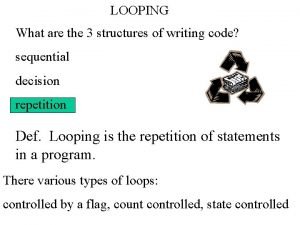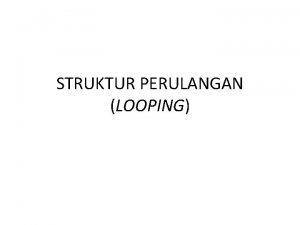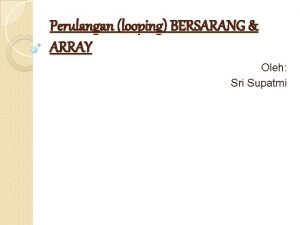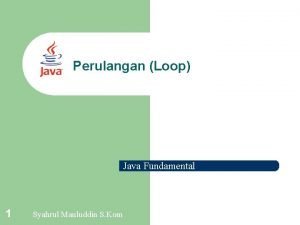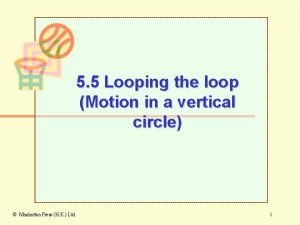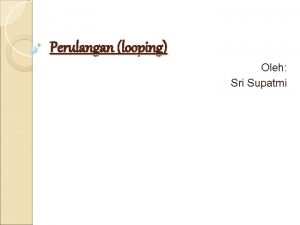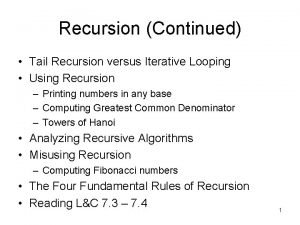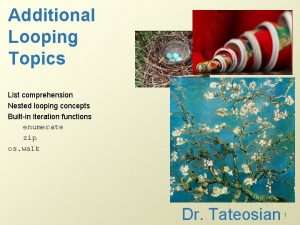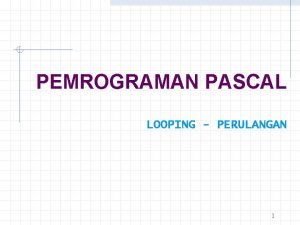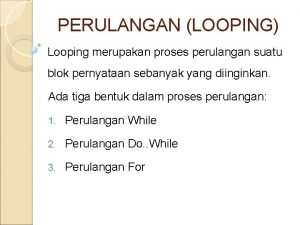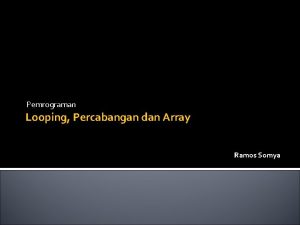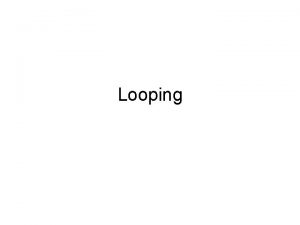10 4 Recursion and Looping Recursion with Two















- Slides: 15

10. 4 Recursion and Looping, Recursion with Two Parameters

Recursion can be Loops � The pool rack example could be implemented using a for loop. � It is also possible to write recursive methods that accomplish things that you might do with a while loop.

Recursion with a Different Base Case �A recursive definition is given below for finding how many times the constant value 2 will go evenly into another number. � The value 1 which is added in the recursive case counts how many times recursion occurs. � This count gives the result of the division. � Notice that in the recursive case n is no longer decremented by 1. � It is decremented by 2.

Recursion with a Different Base Case, cont. � The test for the base case is an inequality rather than an equality since the values that n takes on vary depending on whether it is initially odd or even. � Recursive case: n >= 2 � f(n) = 1 + f(n – 2) � Base case: n < 2 � f(n) = 0

Recursion with a Different Base Case, cont. � Here is a sample implementation. � The recursive method recursive. Division. By. Two() is typed int and takes an int parameter named dividend. � public static int recursive. Division. By. Two(int dividend) �{ � if(dividend < 2) � return 0; � else � return 1 + recursive. Division. By. Two(dividend – 2); �}

Recursion with Two Parameters � Building on this example, it is possible to write a recursive definition for the general division function. � This is shown on the next slide. The function has two parameters. � Adding 1 in the recursive case again counts how many times the recursion occurs. � In this definition the first parameter for the recursive case is dividend – divisor. � The amount decremented each time is always the same, but divisor can be any (positive integer) value. � The second parameter is the divisor, which is passed down unchanged through all of the calls.

Recursion with Two Parameters, cont. � Recursive case: dividend >= divisor � f(dividend, divisor) = 1 + f(dividend – divisor, divisor) � � Base case: dividend < divisor � f(dividend, divisor) = 0

Recursion with Two Parameters, cont. � Here is a complete driver program and an implementation of this function. � As usual, this is not a general implementation, but it works for appropriate input values and illustrates the key points. � Notice that a variable ret. Val is used in the implementation.

Recursion with Two Parameters, cont. � � import java. util. Scanner; public class Gen. Rec. Div. Prog { � public static void main(String[] args) � { � Scanner in = new Scanner(System. in); � int ret. Val; � int dividend, divisor; � System. out. print("Enter the dividend: "); � dividend = in. next. Int(); � System. out. print("Enter the divisor: "); � divisor = in. next. Int(); � � } } ret. Val = Gen. Rec. Div. Class. gen. Rec. Div(dividend, divisor); System. out. println(ret. Val);

Recursion with Two Parameters, cont. � � � � public class Gen. Rec. Div. Class { public static int gen. Rec. Div(int dividend, int divisor) { int ret. Val = 0; if(dividend < divisor) return ret. Val; else { ret. Val = 1 + gen. Rec. Div(dividend - divisor, divisor); } } } return ret. Val;

Recursion for a logarithm � Just as division can be defined by repeated subtraction, finding a logarithm can be defined by repeated division. � For a given number to find the log of, which will be represented by the variable name to. Find. Log. Of, and a given base, a simple recursive definition of the logarithm function would look like this: � Recursive case: to. Find. Log. Of >= base � f(to. Find. Log. Of, base) = 1 + f(to. Find. Log. Of / base, base) � � Base case: to. Find. Log. Of < base � f(to. Find. Log. Of, base) = 0

Recursion for a logarithm, cont. � The following example contains two static methods, both of which find a simple logarithm by doing repeated division. � One does so with looping and the other with recursion. � For positive input consisting of a given double to. Find. Log. Of and a given integer base, the code gives as output the largest integer value less than or equal to the logarithm for that number and base.

Recursion and looping for a logarithm, cont. � � � � � � � import java. util. Scanner; public class Test. Rec. And. Loop { public static void main(String[] args) { Scanner in = new Scanner(System. in); double to. Find. Log. Of; int base; double answer; System. out. println("What number would you like to find the log of? "); to. Find. Log. Of = in. next. Double(); System. out. println("What should the base of the logarithm be? "); base = in. next. Int(); answer = Recursion. And. Looping. my. Log. Looping(to. Find. Log. Of, base); System. out. println("The looping answer is: " + answer); answer = Recursion. And. Looping. my. Log. Rec(to. Find. Log. Of, base); } } System. out. println("The recursive answer is: " + answer);

Recursion and looping for a logarithm, cont. � � � � � � � � public class Recursion. And. Looping { public static int my. Log. Looping(double to. Find. Log. Of, int base) { int ret. Val = 0; while(to. Find. Log. Of >= base) { to. Find. Log. Of = to. Find. Log. Of / base; ret. Val++; } return ret. Val; } public static int my. Log. Rec(double to. Find. Log. Of, int base) { int ret. Val = 0; if(to. Find. Log. Of < base) return ret. Val; else { to. Find. Log. Of = to. Find. Log. Of / base; ret. Val = 1 + my. Log. Rec(to. Find. Log. Of, base); return ret. Val; } } }

Different Way for the Recursive Method �Note that the following version of the recursive method is shorter, but it might also be a little bit harder to understand. � � public static int my. Log. Rec(double to. Find. Log. Of, int base) { int ret. Val = 0; � � � if(to. Find. Log. Of > base) { to. Find. Log. Of = to. Find. Log. Of / base; ret. Val = 1 + my. Log. Rec(to. Find. Log. Of, base); } � � return ret. Val; }
 To understand recursion you must understand recursion
To understand recursion you must understand recursion What is decision making and looping in c
What is decision making and looping in c Dangling activity in network diagram
Dangling activity in network diagram Flowchart counter loop
Flowchart counter loop Looping and graphics in small basic
Looping and graphics in small basic Contoh flowchart perulangan
Contoh flowchart perulangan Looping pascal
Looping pascal What is looping in writing
What is looping in writing Bentuk umum dari pernyataan perulangan for adalah
Bentuk umum dari pernyataan perulangan for adalah Qbasic loops
Qbasic loops Nested array
Nested array Perulangan bersarang java
Perulangan bersarang java Disadvantages of looping in education
Disadvantages of looping in education Loop aircraft motion
Loop aircraft motion Apa makna repetition dalam struktur dasar algoritma
Apa makna repetition dalam struktur dasar algoritma Looping pemrograman
Looping pemrograman







